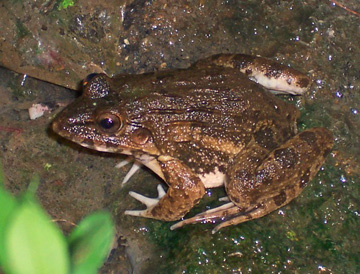The frogs that are found in most American back yards fill up on flies, mosquitoes, and other insects. But a frog that’s found in southeastern Asia goes after slightly bigger quarry – including small crabs.
The crab-eating frog isn’t some monster – it grows to only about three inches long. Even so, it’s not your average frog. In fact, it does something that no other frog can do: It can live in both fresh water and salt water.
 Crab-eating frog. Credit: W.A. Djatmiko, Wikipedia
Crab-eating frog. Credit: W.A. Djatmiko, WikipediaThe frog inhabits coastal regions from India to Indonesia. It lives in freshwater ponds near beaches, as well as irrigated rice paddies and other human-made wet zones. But it’s just as comfortable in the salty environs along the shore, such as mangrove forests and swamps.
Other frogs dry out when they’re dunked in salt water. But the crab-eating frog has a couple of mechanisms for coping with the different environment.
For one thing, it produces more urine, which seeps through the wall of the bladder and into the frog’s tissues. And for another, its skin is less permeable than that of other frogs, so it traps more water inside the frog’s body. The frog can’t just hop from fresh water to salt water, though – it takes a few days for its body to adapt to the change.
Even so, it can be worth it. Getting away from a freshwater habitat allows the frog to get away from other species of frogs and other animals that compete with it for food, as well as from possible predators. And it expands the frog’s food choices – among other things, adding crab to its daily menu.

